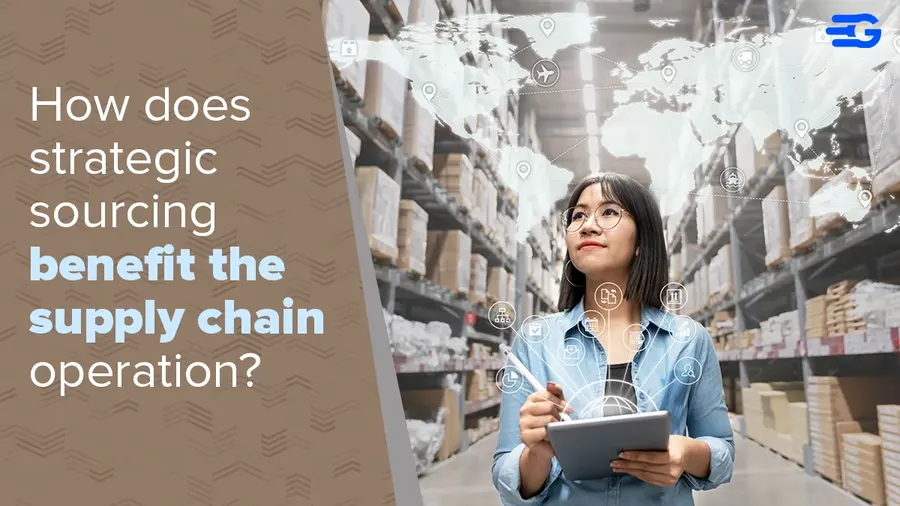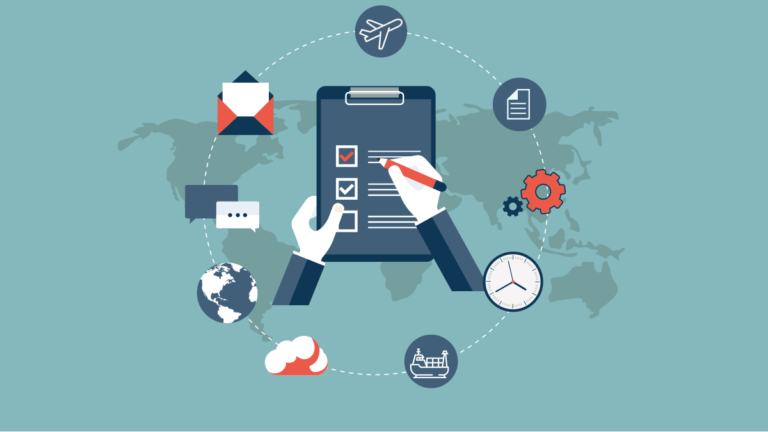Mastering Strategic Sourcing: A Guide for Modern Procurement
Despite its often underestimated importance, sourcing is vital for modern supply chains. Statistics underscore its criticality: Over 90% of supply chain disruptions originate from suppliers, emphasizing the need for strategic sourcing’s agility and resilience. In today’s business landscape, procurement has transcended its traditional role to become a strategic powerhouse. Strategic sourcing empowers procurement managers, supply chain leaders, and strategists to optimize costs, cultivate robust supplier partnerships, and steer organizational success.
The Pillars of Strategic Sourcing
Strategic sourcing rests upon three fundamental pillars that act as the bedrock for successful implementation:
- Market Analysis: Uncovering Opportunities as well as Risks.
In navigating the professional landscape, a comprehensive grasp of market dynamics is paramount. This entails delving into intricate price trends, discerning diverse supplier capacities, and scrutinizing both established competitors and emerging contenders.
Market research serves as the compass guiding the exploration of alternative sourcing avenues, the negotiation of advantageous volume deals, and the anticipation of future market demands. Leveraging methodologies like market research reports, industry publications, and competitor analyses is essential in steering this crucial phase with precision and foresight.
- Supplier Evaluation: Choosing the Best Partners
Ensuring you’re partnered with the right suppliers extends far beyond just price considerations. Strategic sourcing demands a holistic approach, examining various crucial facets. A thorough evaluation process should explore dimensions such as:
Quality: Guaranteeing that shipments reach their destination reliably and consistently, meeting or surpassing established standards. Rigorous quality control measures are imperative, verifying carriers’ capacity and performance track records to ensure seamless delivery.
Reliability: Avoid production delays or service interruptions by assessing suppliers’ history of timely and consistent performance.
Innovation Capabilities: Partnering with forward-thinking suppliers fosters access to cutting-edge innovations, maintaining your industry leadership. Evaluate suppliers’ investment in research and development.
Financial Stability: Mitigate supply chain risks by examining suppliers’ financial health through credit reports and industry insights.
Sustainability Practices: Aligning supplier values with your own promotes brand integrity amidst growing consumer concern for environmental and social issues. Assess vendors’ ethical procurement and eco-friendly production practices, utilizing GoComet’s carbon tracking to make informed decisions.
By meticulously evaluating these aspects, you fortify your supply chain, enhance efficiency, and bolster customer satisfaction, ultimately propelling your business towards sustained success.
- Risk Management: Proactive Mitigation for a Resilient Supply Chain
Consider the impact of proactive risk mitigation on your supply chain. It makes it more robust and helps to avoid possible supply chain disruptions. Strategic sourcing involves identifying and mitigating potential risks, such as:
Supplier Dependence: Single sourcing can bring disruptions to your business if you are completely dependent on a sole supplier. Diversify the supplier base and have alternative sourcing methods in place to mitigate that risk.
Supply Disruptions: In the face of supply disruptions triggered by geopolitical events, natural disasters, or labor disputes, it’s essential to activate contingency plans and explore alternative sourcing avenues to mitigate impacts. Instances like port congestion and crises such as the Red Sea disruption underline the importance of proactive measures. Leverage GoComet’s solutions for efficient supply chain management, enabling better navigation through challenges and ensuring continuity in operations.
Economic Fluctuations: The fall in the economy can affect the suppliers’ pricing and availability. Ensure that contracts are tailored and contain built-in price adjustments that can offset the impact of economic instabilities.
Creating a strong structure that incorporates these main pillars becomes the foundation for the good implementation of strategic sourcing.
Benefits of Implementing Strategic Sourcing
By adopting a strategic sourcing approach, businesses unlock a treasure trove of significant advantages:
Forge Transformative Partnerships: By employing strategic sourcing, suppliers can develop partnerships with companies that are on a far more collaborative level than those based purely on the transactional model. It prioritizes transparent discussion, agreed-upon mutual problem-solving, and a common perception of achievement. The collaborative way how this can be achieved is to build trust and long-term partnerships that deliver quality all the time. Practices like co-designing business plans and working out supply-side development programs can make suppliers become better associates.
Mastering the Art of Cost Efficiency: Strategic sourcing ensures cost optimization for procurement in the overall process. By way of market analysis, value engineering (finding alternate materials or processes to reduce expenses without compromising the quality), and negotiations with the suppliers you can identify a chance for cost saving and finally get the best value within your budget. Checking for volume discount perspective and category-based grouping of the same kind of products can contribute to the effectiveness of procurement.
Revolutionize Quality and Innovation: Delivering Outstanding Suppliers Strategic sourcing, on the other hand, forms a partnership with the TOP suppliers. # Once you establish a relationship with innovative suppliers who are committed to continuous improvement, you garner access to their most advanced solutions while the quality of your products is upgraded and service levels are raised. Frequent reviews together with suppliers about product development can be a powerful driver for the external workforce.
Build Resilience, Secure Success: In a Nutshell The storm known as strategic sourcing does not only help to strengthen your supply chain by preventing possible risks and assuring a continuous flow of goods and services but also provides uncountable benefits. Variety of your suppliers, looking for alternative sources of supply, and evaluation risks and their reliability are means of minimizing a loss of continuities and gaining and withdrawing of reliabilities from the suppliers. The consequent Sourcing partnership among suppliers from different geographical locations will add more strength and assurance.
Aligning Procurement with Business Goals
Strategic sourcing plays a pivotal role in aligning procurement activities with broader business objectives. This alignment ensures that your procurement function operates not just efficiently, but also strategically, supporting the overall growth and success of the company. Here’s how it’s achieved:
- Understanding Business Needs: The Foundation for Strategic Sourcing
Strategic sourcing starts by thoroughly comprehending your company’s long-term goals and growth strategies. This understanding becomes the foundation for your sourcing decisions. Conduct in-depth discussions with key stakeholders across various departments, including sales, marketing, and product development, to gain a holistic view of the company’s needs. Analyze future product roadmaps, market trends, and anticipated customer demands. By aligning your sourcing decisions with these factors, you ensure that procurement directly supports the company’s strategic objectives.
- Developing Sourcing Strategies: A Roadmap to Success
Based on your business priorities, you can develop tailored sourcing strategies that define the roadmap for your procurement activities. These strategies should encompass the following:
Sourcing Objectives: Clearly define your objectives for each category you procure. Are you prioritizing cost reduction, quality improvement, or access to cutting-edge technology?
Supplier Characteristics: Outline the preferred characteristics of your ideal suppliers. This could include factors like industry expertise, geographic location, specific certifications, or a proven track record in innovation.
Evaluation Criteria: Establish clear criteria for evaluating potential suppliers. This could include cost proposals, quality performance metrics, delivery lead times, and responsiveness to customer needs.
By developing comprehensive sourcing strategies that align with business goals, you ensure that your procurement efforts are targeted and deliver maximum value.
The Strategic Sourcing Process: A Step-by-Step Guide
Strategic sourcing is a structured process that ensures efficient and effective procurement. Here’s a step-by-step breakdown, guiding you through each stage of implementation:
- Category Identification & Assessment:
- Identify and categorize your spending based on product types, services, or raw materials. This helps you gain a clear picture of your procurement landscape.
- Analyze historical data to understand current spending patterns within each category. Identify areas with high spending volumes or recurring inefficiencies. This data analysis lays the groundwork for optimization opportunities.
- Market Research & Supplier Identification:
- Conduct thorough market research to identify potential suppliers within each category you have identified. Utilize industry reports, online directories, trade shows, and industry publications to expand your supplier pool.
- Consider attending industry conferences and participating in online supplier communities to connect with potential partners.
- Supplier Evaluation & Shortlisting:
- Evaluate potential suppliers based on the predefined criteria established in your sourcing strategies. Request quotes, conduct reference checks, and potentially schedule site visits to assess supplier capabilities firsthand.
- Shortlist a select group of qualified suppliers (typically 3-5) for further engagement and detailed negotiations.
- Request for Proposal (RFP) & Negotiation:
- Issue a detailed RFP outlining your specific requirements, evaluation criteria, and desired timeline for responses. The RFP ensures all potential suppliers are presented with the same information and allows for a fair and objective evaluation process.
- Negotiate pricing, contracts, and terms with shortlisted suppliers to secure the most favorable deal. Negotiations should focus not just on cost, but also on factors like payment terms, delivery schedules, and quality control procedures.
- Supplier Selection & Award:
- Based on a comprehensive evaluation of proposals, negotiation outcomes, and reference checks, select the supplier that best aligns with your strategic objectives and offers the most value proposition.
- Award the contract and finalize agreement terms, clearly outlining expectations, deliverables, and performance metrics.
- Contract Management & Performance Monitoring:
- Implement a robust contract management process to ensure compliance with agreed-upon terms. This includes monitoring supplier performance against key metrics like on-time delivery, quality control standards, and responsiveness to communication.
- Conduct regular reviews with suppliers to discuss performance, identify areas for improvement, and foster a collaborative relationship.
- Continuous Improvement: A Commitment to Excellence
- The strategic sourcing process is cyclical and continuous. Regularly review your sourcing strategies, supplier performance data, and market trends. Identify opportunities for cost savings, improved quality, or diversification of your supplier base.
- By continuously monitoring and adapting your approach, you ensure that your strategic sourcing efforts remain optimized and deliver ongoing value to the organization.
Leveraging Technology in Strategic Sourcing
Technology plays a vital role in optimizing the strategic sourcing process, streamlining workflows, and enhancing efficiency. Here are some key technological solutions that can empower your procurement team:
- E-Procurement Platforms: Cloud-based e-procurement platforms like GoProcure automates manual tasks such as requisitioning, vendor onboarding, and contract management. This frees up valuable time for procurement professionals to focus on strategic initiatives and supplier relationship management. These platforms also offer features like:
- Streamlined approval workflows
- Real-time spend visibility
- Automated data analysis for informed decision-making
- Supplier performance dashboards
- Supplier Relationship Management (SRM) Systems:SRM systems help build stronger relationships with key suppliers. These systems provide features for:
- Supplier performance tracking
- Collaboration tools for communication and information sharing
- Risk management modules to identify and mitigate potential supplier issues
- Self-service portals for simplified supplier interactions
- Big Data and Analytics: Leveraging big data and analytics empowers you to extract valuable insights from your procurement data. This can be used to:
- Identify spending patterns and potential cost-saving opportunities
- Predict market trends and anticipate price fluctuations
- Optimize negotiations with suppliers based on data-driven insights
- Artificial Intelligence (AI) and Machine Learning (ML): AI and ML can be used to automate repetitive tasks, identify sourcing opportunities, and predict supplier performance. This allows for:
- Automated supplier identification and pre-qualification
- Dynamic pricing models for flexible contract negotiations
- Predictive analytics to anticipate supply chain disruptions
By integrating these technological solutions into your strategic sourcing process, you can significantly enhance efficiency, gain valuable insights, and make data-driven decisions that optimize your procurement operations.
Overcoming Challenges in Strategic Sourcing
While strategic sourcing offers substantial benefits, it’s not without its challenges. Here are some common roadblocks and strategies to overcome them:
- Lack of Internal Alignment: Ensuring alignment between procurement and other departments is crucial.
Solution: Foster collaboration by involving key stakeholders across departments in the sourcing process. Communicate the value proposition of strategic sourcing and its contribution to broader business goals.
- Resistance to Change: Implementing a new sourcing process can encounter resistance from established ways of working.
Solution: Develop a comprehensive change management plan. Provide training and education to procurement professionals and stakeholders across the organization. Highlight the benefits of strategic sourcing and address any concerns transparently.
- Limited Resources: Resource constraints can hinder effective implementation.
Solution: Prioritize strategic sourcing initiatives based on potential impact. Explore outsourcing opportunities for non-critical tasks. Advocate for additional resources based on the potential return on investment (ROI) strategic sourcing can deliver.
- Data Quality Issues: Inaccurate or incomplete data can lead to poor decision-making.
Solution: Implement data governance practices to ensure data quality and consistency. Invest in data cleansing and standardization efforts.
By proactively addressing these challenges and establishing well-defined strategies, you can ensure a smooth implementation of your strategic sourcing program.
Future Trends in Strategic Sourcing and Procurement
The future of strategic sourcing is constantly evolving, driven by technological advancements and changing market dynamics.
- Sustainability Focus: Sustainability will continue to be a major driver in strategic sourcing decisions. Companies will increasingly prioritize partnering with suppliers who share their commitment to environmental and social responsibility.
- Digital Transformation: Digitalization will continue to revolutionize procurement practices. Advanced technologies like AI, blockchain, and the Internet of Things (IoT) will further streamline workflows, enhance data analysis capabilities, and provide greater transparency in supplier relationships.
- Collaborative Sourcing: A shift towards collaborative sourcing models is expected. This approach emphasizes co-creation and innovation with key suppliers, fostering a more strategic partnership that benefits both parties.
- Risk Management: Managing supply chain risks will remain a top priority. Companies will leverage advanced analytics and scenario planning to identify and mitigate potential risks more effectively.
By staying abreast of these evolving trends and implementing adaptable strategies, your procurement function can remain future-proof and continue to deliver significant value to your organization.
Conclusion: The Strategic Value of Sourcing
Strategic sourcing is actually beyond the mere obtaining of goods and services It affects a company’s supply chain operations to a level where it can be used as a strategic business function to indirectly or directly drive a company’s success. Do this by having the right framework, using the best technology and frequently optimizing the ideas and you will realize that strategic sourcing is achievable. It protects you from the risks. It’s a tool that enables you to build strong supplier relationships, manage costs, optimize physical risks, and finally drive the growth of the organization. However, keep in mind that, this strategic sourcing is a never-ending, not a one-way street journey When you do this, you end up having to continue improving your approach to fit with the dynamic nature of the procurement market. Thus, this way you can make sure the procurement function of your company becomes a strategic asset with long-term value.






